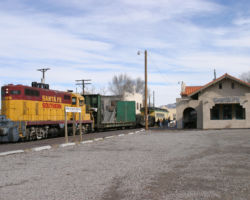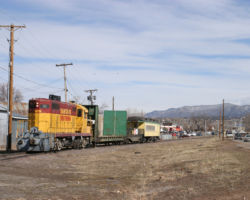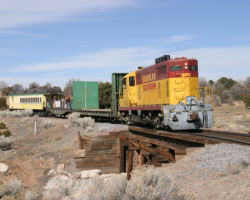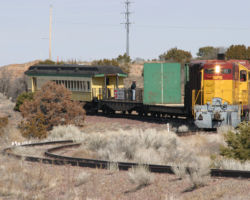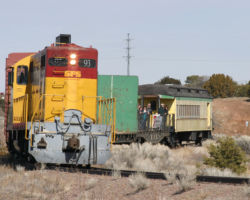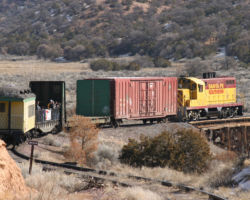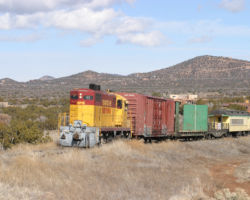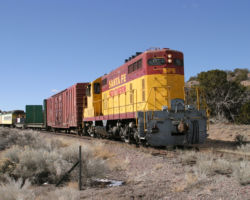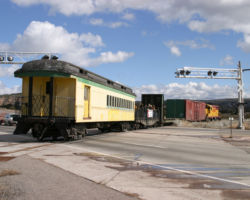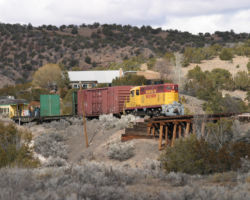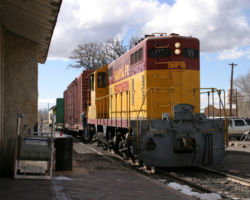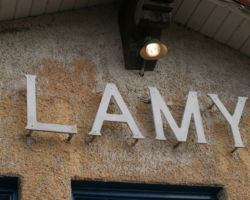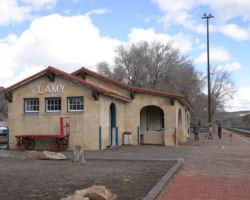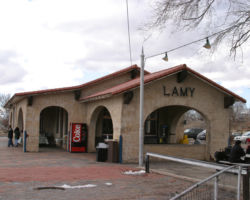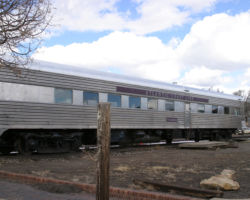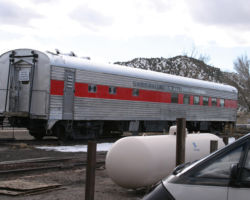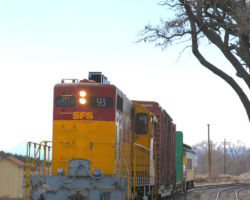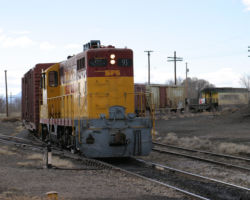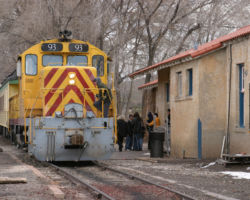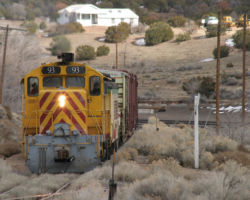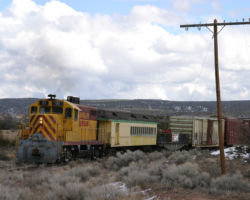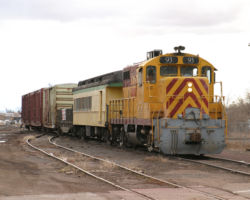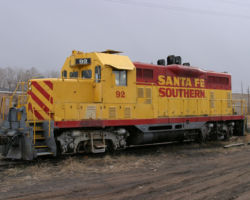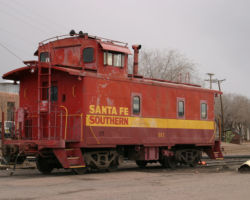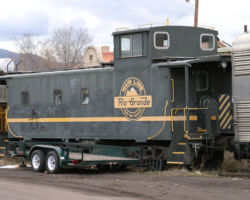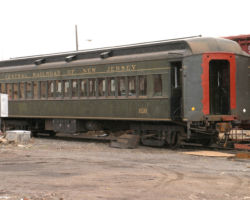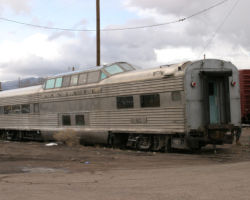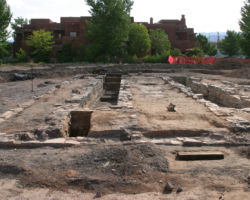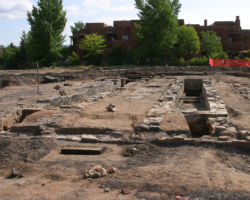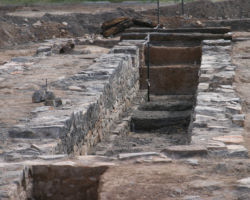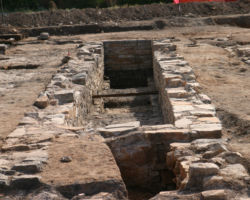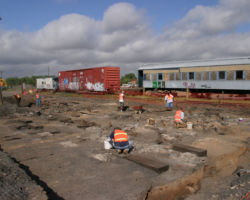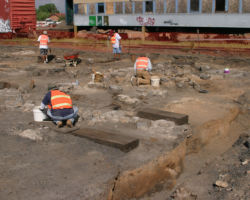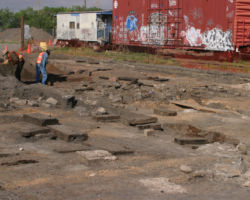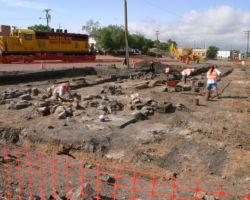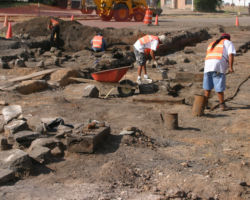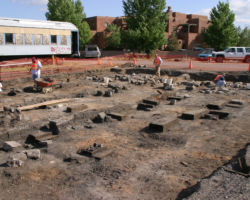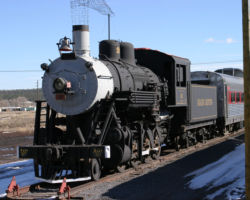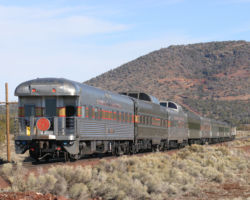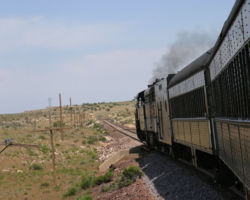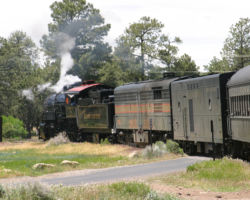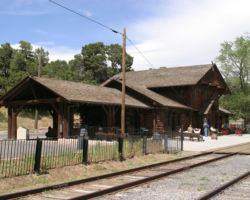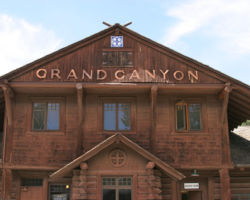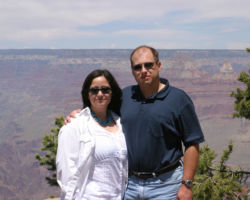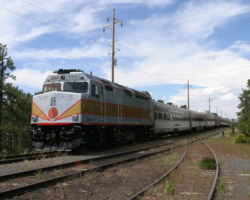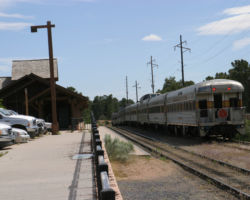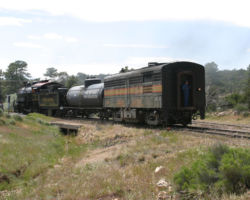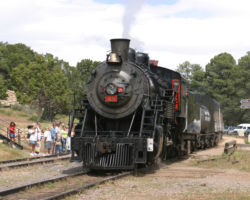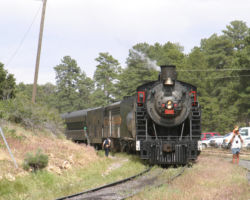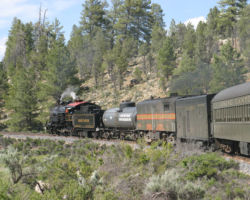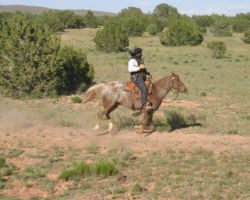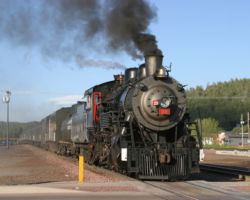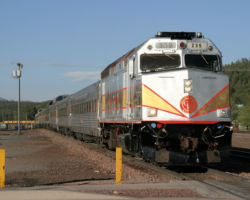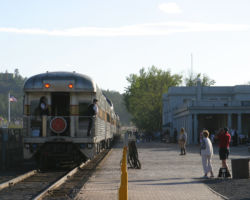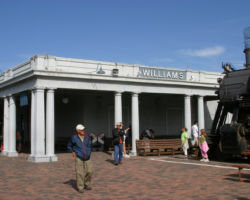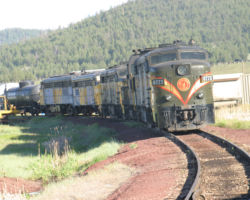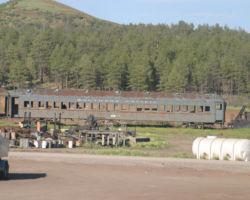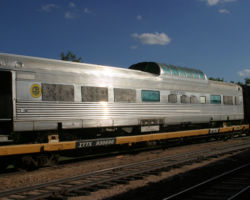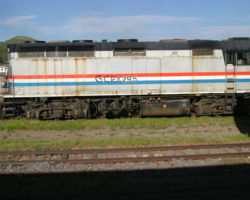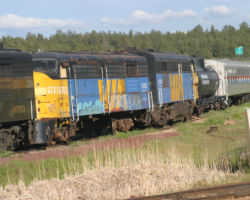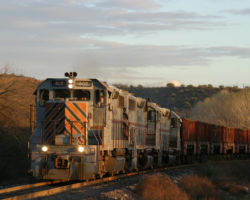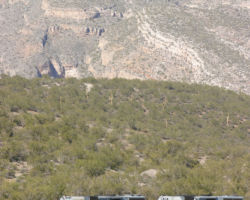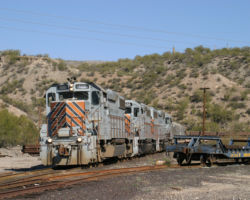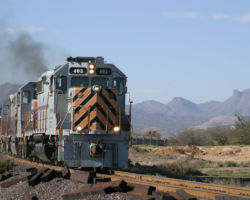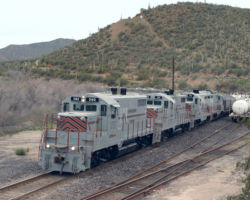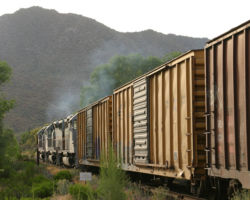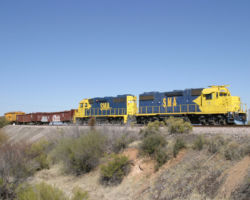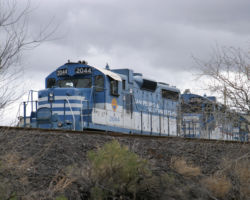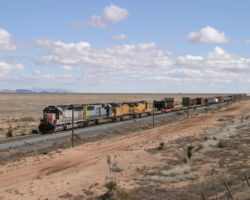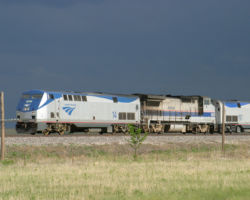Santa Fe Southern – Jan 31, 2005
The “Santa Fe” part of Atchison, Topeka & Santa Fe, was really a statement of the railroad’s western goals, rather than a point it initially connected. Founded by the Spanish back in 1607 (or 1610, depending on the source), centuries before the railroad came about, it was one of the stated destination of the original ATSF mainline over Raton Pass. However, because of its positioning high on the Galisteo Plateau, ATSF engineers found it difficult, if not impossible, to come up with a mainline alignment actually passing through town. The ATSF decided that its namesake town would have to be bypassed, upsetting many local residents and businessmen. In order to get itself hooked into the burgeoning railroad network, the city of Santa Fe subsidized construction (to the tune of a $150k bond) of a branch from the city to a point on the mainline some 18 miles distant, then called Galisteo Junction. The branch was complete on 9-Feb-1880, and regular passenger and freight service began a week later.
By 1992, the majority of Santa Fe freight went via the Belen Cutoff, a faster, lower grade route about 100 miles south. The ATSF itself would only exist for another two years, before being merged with BN to form today’s BNSF. Galisteo Junction was now known as Lamy, renamed after Archbishop of Santa Fe, Jean Baptiste Lamy (1814-1888). Most importantly to this story, the ATSF no longer wanted the Santa Fe branch, and was looking to sell it. Two bids came in – one from a scrapper looking to tear out the line, and the other was a new shortline, the Santa Fe Southern. Needless to say, the line was sold to the SFS. Freight operations began in 1992, with passenger excursion service added in 1993. The line continued growing its freight and passenger operations over the next decade, hauling some 23,000 passengers per year recently. During January of 2005, another major change occurred – the SFS corridor was sold again to the State of New Mexico. This change leaves the SFS as the rail operator on the line, but protects the corridor for the public Santa Fe Rail Trail as well as for future commuter rail expansion as part of the New Mexico Rail Runner system.
I was driving across the Southwest to get to Phoenix, AZ, for work on Monday, 31-Jan-2005, and decided to hit the SFS as my first stop of the trip. The SFS operates two major types of passenger trains – the “Scenic Day Trains” and the “Hot Shots”. They also run a number of special trains during other parts of the season – see their full 2005 schedule here. The Scenic Day Trains are real, honest mixed freights. In addition to hauling passengers from Santa Fe to Lamy and back, they stop along the line, switch out freight cars at customers, and interchange freight with BNSF at Lamy. They’re one of the few railroads that does this in 2005 (apparently the Santa Cruz, Big Trees, & Pacific also does this when they get freight, and the A&M used to… Thanks to zephyrus from Trainorders for this detail!), despite it having been common practice back in the day. During the off season, these mixed trains only run on Tuesday, Thursday, and Saturday, departing Santa Fe around 1100h and returning around 1530h. It just so happened that I’d be waking up in Santa Fe on Saturday, 29-Jan-2005, so I figured I’d go chase this little shortline.
As with many winter days around here, things started off cold, but relatively clear, with only a few high clouds messing with the light. Trips always start at the ATSF depot in downtown Santa Fe. This is actually the second depot for the ATSF in Santa Fe, having been built in 1909. It’s at the north end of a small yard where the SFS stores its power and numerous interesting railcars, and located just south of the junction of Aqua Fria and S. Guadalupe Streets. If you take US 84/285 north through town, just drive north until you see the railroad cross the road, then look right. You’ll figure it out from there – it’s really quite easy to find.
The small railroad currently rosters two diesel locomotives, 92 and 93. SFS 93 began life in September of 1952 as Louisville & Nashville’s GP7 414 (EMD serial 17242, frame 5128-5). It then became LN 2304, where it was rebuilt by new owner Seaboard Coast Lines to a GP16, SCL 4804. From there, it proceeded to be painted as SBD 4804, CSXT 1850, MNVA 1850, MCTA 1850, and finally, SFS 93. The road’s other unit, SFS 92, was built in July 1953 as ATSF GP7 2861 (EMD serial 18566, frame 5288-13). It was later rebuilt as ATSF GP7u 2075, and then sold to the SFS as their 92. Both units are now painted in the distinctive SFS red and yellow scheme, and sit around Santa Fe when not out on the line. 93 seems to be the preferred unit lately, as I haven’t ever seen 92 moving.
Today’s train would be powered by SFS 93. (Photo #1) Following it was an empty green BN bulkhead flatcar, the SFS’s open air passenger flat (SFS 99), and a 1920s vintage heavyweight coach/baggage car from the defunct Kettle Moraine Railway in Wisconsin (SFS 300). (The SFS itself has a page on their equipment here.) I set up the first shots just south of the ugly US 84/285 / Cerrillos Road crossing, where there was a large parking lot in which to sit and wait. There wasn’t much waiting to do, however, as departure was only a couple minutes behind schedule (1100h). (Photo #2)
From this point, the railway is out of site from US 84 for about a mile, until at Siringo Road, the line comes due east to work its way down off of a mesa. It’s a nice steep grade with a sharp corner at the bottom – on a trestle over the Arroyo de los Chamisos, no less! This area is easily accessed (like most of the SFS route) via a parallel trail. Also, there’s a convenient trailhead parking lot at Zia Road, where it’s a quick jog back to the trestle itself. If, as is my usual luck, you get stopped by every traffic light imaginable, then you’ll get to this spot only marginally ahead of the train (Photo #3).
From that point, I decided to pass up any more shots on the north side of the freeway to go set up at an S-curve I’d found on a previous trip. If you take US 84/285 to the freeway but don’t actually get on I-25, you’ll wind up at a T-intersection with Old Aqua Fria Road. Take this west, then as soon as you’ve crossed the railway, hang a left. Follow this down and you’ll find some amazing photographic possibilities as the trackage descends from Santa Fe across the Arroyo Hondo. I actually spent quite a bit of time waiting for the train here and thinking about how to set up the best shots. Eventually I started wondering if somehow he’d gotten past me and was on down the line. Ol’ 93 did eventually show, though, as I was getting restless and thinking about leaving. As it turns out, they’d stopped at a customer to pick up a BNSF beer car (presumably empty and returning to the factory, BNSF 780890). Like I said, this is a real, working mixed train! (Photos #4,5,6)
South of this point, the line is really only accessible by walking, biking, or horseback on along the trail until a couple of crossings in the Eldorado subdivision. (There’s supposedly a road to 9 Mile, but I couldn’t find it…) To get to the Eldorado area, it’s best to just hit the freeway back east to interchange 290, then take US 285 south to Avenida Vista Grande, about a mile and a half. Take this road back west, and you’ll come to the grade crossing. As a note, you won’t have nearly as much time on the train as you think, so hurry along… The railroad’s radio base appears to be located at this point, as to the south of the road you’ll see a steel shed and an antenna on a pole. Even through a subdivision, it still makes for a decent shot of the train. (Photo #7)
Next stop was the US 285 crossing, just west of Lamy itself. There are a couple other ways to get to the line in the subdivision, but I didn’t want to take waste a lot of time. Partially this was because I was startled at how quickly the mixed had made the Vista Grande crossing, but it was largely due to not wanting to navigate the area’s muddy roads in a low clearance car. Getting stuck in the mud tends to ruin the day rather quickly. Turns out it’s easy to beat the train through this stretch, as when 93 and train did show up, they were moving much slower than before. Presumably this is due to the grade in the area – the line drops off rapidly to descend into Lamy. (Photos #8,9) Leaving US 285 and heading east into town, there’s another trestle visible high above the road which made for a nice shot. (Photo #10). From there, it’s a short drop down across the road, through the wye, and into the SFS track on the north side of the Lamy depot. (Photo #11)
While the passengers were fed and explored Lamy, the train crew went about interchanging the empties with BNSF and rearranging the train for the return trip. (Photos of Lamy will be in the next chapter.) In addition to the classic ATSF depot at the junction (Photo #12,13,14), there are several railcars sitting around that are rather interesting. The first is painted as the Atlantic Coast Line’s Talladega on the south side (Photo #15) and as the Lamy Railroad & History Museum on the north side. Unfortunately it was closed for renovations, or I would have tried to find out more about it. The second interesting car sits against the bumping post at the far end of the SFS’s track by the depot. It’s obviously a semi-permanent fixture, having a deck attached and being well wired. The only markings were PPCX 700100 and the name Hamilton. I have no idea who owns the car, but it looks like it’s essentially a private residence, so my guess is that it’s somebody quite connected with the SFS. (Photos #17,18)
The trip back to Santa Fe was relatively uneventful. While we were all in Lamy, a storm had rolled in, both fouling up the light and causing brief torrents of sleet balls to fall from the sky. Also, my stomach and gas tank were both running a little low, so after catching up with the mixed at the US 285 crossing, I highballed straight back to Santa Fe. After filling the tank and finding something to eat, I heard 93’s horns go off for the crossing just beyond the freeway. So, I drove up along the tracks (Galisteo Street) until I found a nice trestle and curve, and proceeded to wait. (Photo #24) From there, it was only a couple of miles into the yard, and I caught it one more time on the way in (Photo #25). I photographed a few more things in the yard, like the two Rio Grande cabooses and the ATSF’s dome/lounge car Plaza Lamy, and after I’d been hit with all the sleet I could take, got back in my car and headed for Los Cruces. One of these days I’ll make it back and actually ride the train, but regardless, the SFS is a fun, often forgotten, little shortline to chase around.
Four months later, I returned to Santa Fe on vacation with my wife. The area around the depot is undergoing redevelopment as part of the Santa Fe Railyard project. While digging, they discovered the remains of an old two stall Santa Fe enginehouse, then the first depot (1880-1909) that was then used as a freight house, and apparently a few other things as well. The Museum of New Mexico was called in to do a full dig on the site and document it before parts of it were obliterated by the construction. Specifically, the enginehouse foundation will be destroyed as an underground parking garage is built. So, while I’m going to try to get a copy of the official report once all is said and done, I took a few of my own photos from behind the orange plastic fence to try to document what was there. Photos #32-37 are of the old enginehouse, where light repairs were done on power running on the branch. Photos #38-43 are of something else they were digging up. My guess is that this is the remains of the first ATSF depot, which was used as such between 1880 and 1909. After that, it became a freighthouse before it was demolished completely. Enjoy these – most likely, by the time I write this, some of this will already be gone.
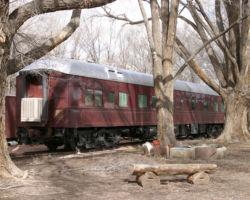
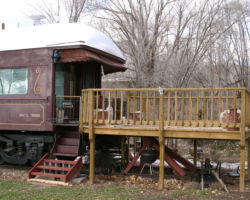
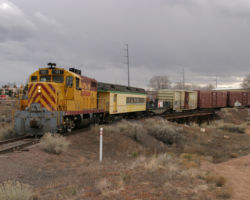
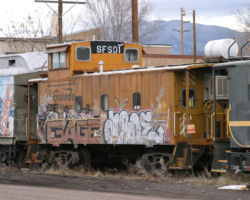
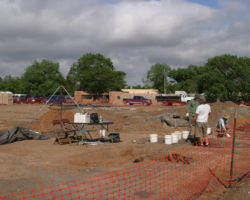
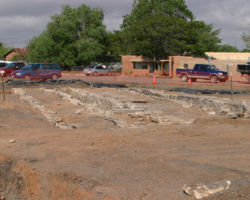
Grand Canyon Railway – May 29, 2005
What’s now the Grand Canyon Railway started in the late 1890s as the Santa Fe & Grand Canyon Railroad, spearheaded by a guy oddly known as William Owen “Buckey” O’Neill and funded by the investment house Lombard, Goode, and Company. Publicly, it was justified as a mining branch to the Francis Mining District, near Anita station (about milepost 53). Here, copper ore had been found that assayed out higher than anything else found in the state – up to sixty five percent copper. Privately, however, the potential was realized as a tourist hauler. However, first and foremost was the mining, as that’s where the perceived profit would come from. Thus, by 15-Mar-1900, the line was completed using poor grading, light (52 and 56 pound) rail, and two leased Santa Fe steamers. This gave them 53 miles of main, along with yard trackage and the 3 mile spur at Anita. The line provided access to the mining district, with some 10 unconstructed miles to go to the Canyon rim itself. Unfortunately, the capital wasn’t yet available to complete the branch for its secondary purpose – tourism.
The Francis District mining boom quickly turned to a mining bust, however. Most of the ore deposits were near the surface, with the deepest vein only going a bit over 500 feet down. Basically, the guesses at vast riches beneath the surface based on surface minerals were all dead, flat wrong. Combined with various other problems, such as a Santa Fe-induced “water shortage”, the SF&GC was in dire financial straits. By 5-Sep-1900, the line was bankrupt and in the hands of the courts. As everyone expected, the road’s assets were sold to the Santa Fe on 15-Aug-1901, who promptly reformed it as the Grand Canyon Railway Company, a separate company, but firmly in the pocket and under the protection of the Santa Fe itself.
By the Santa Fe purchase, nearly all the originally-forecasted mining traffic was gone, with the last major copper interest closing up shop a few years later 1905. The most logical thing was to go after the secondary goal – tourism. Using the might of the parent road, the tracks were complete to the Canyon a month after the purchase, with a whole laundry list of upgrades planned after that. The first through passenger run was on 17-Sep-1901, keeping a roughly three hour schedule each way.
Over the next seventy years, tourism was the driving force behind the line. The railroad was instrumental in setting up facilities on the South Rim to make it a tourist destination. The first of these, the El Tovar Hotel, was designed and built by the ATSF and the Fred Harvey Company, famed operators of the Harvey Houses along the Santa Fe’s routes. Opened in 1905, it continues as one of the premier hotels of the National Park Service today. They went on, building infrastructure such as the water facilities and the powerhouse, as well as more well known structures, like the Phantom Ranch and the Hopi House. In 1916, Congress finally got around to setting up the Grand Canyon as a National Park, assuring a booming tourist industry for years to come.
The line was not without other business, however. The Saginaw and Manistee Lumber Company operated a vast network of logging lines stretching east from the Grand Canyon line at Apex. Starting in 1928, the company built dozens and dozens of miles of track through the Kaibab National Forest, mostly to the east of what is now AZ 180. Two Baldwin 2-6-0s and a Shay (road numbers 2,3, and 4, respectively) would haul strings of log cars out to the Santa Fe interchange, where a local Santa Fe job would haul them to the mill in Williams and then return the empty cars for more. A short eight years later, the logging lease was exhausted, and the line was torn up. What wasn’t worth reuse or selling was burned and scrapped on site. Locomotives 3 & 4 are reported to have lasted until 1941 before being cut up. 2 lasted a while longer, but was scrapped sometime during World War II. Also, supplies inbound to the Canyon rim (water and fuel), as well as livestock (cattle and sheep) and rock (sand and gravel) made up most of the rest of the traffic through the 1960s. Some amount of uranium ore was hauled out of the Orphan Mine between the late 1950s and 1969. The mine was actually located in the Park, just west of the modern South Rim facilities.
WWII brought the first time that passenger service shut down on the line. With personal travel curtailed, the last scheduled runs being on 29-Sep-1942. Nearly four years would pass for the Grand Canyon railway while the war raged. Once the war had ended, though, the line reopened for passenger service at the end of May 1946. In the last two weeks of July 1953, the line would see its heaviest service ever. During that period, some 20,000 Boy Scouts rode the rails to the Canyon in some 53 special trains, composed of 669 railcars. Unfortunately, despite the booming numbers, that rubber-tired nemesis of passenger rail was making inroads. Even by 1927, the number of passengers coming in by car was outstripping the railroad. By the 1950s, with automobiles everywhere and the road system improving quickly, days were numbered for the Grand Canyon passenger trains. In 1967, passenger levels dropped to a little of 4600 riders for the season, and the decision was made to discontinue service. On 30-Jul-1968, ATSF 730 lead the last passenger train, consisting of a baggage car and a coach, to the South Rim of the Canyon and back. Some sixty-seven years of nearly continuous tourist hauling came to a close, most believed forever, but some limited specials and freight traffic continued. Then, on 20-Jun-1974, the rails went completely silent. ATSF 3402 and 3388 went to retrieve a few gons full of recovered scrap track material. With their arrival back at Williams, ATSF operation of the branch would end forever.
In 1980, the Santa Fe filed for abandonment of the branch. By 1983, with abandonment approved, the ATSF contracted the scrapping to Railroad Resources. Instead of scrapping it, they decided to purchase it and attempt to bring back passenger operations. It’s not every day the scrapper decides to buy the line outright and keep it intact! Just like the original SF&GC, however, Railroad Resources couldn’t manage to raise the necessary funds to rehabilitate the line. In the end, it just didn’t make it, and they attempted to scrap the line in 1986 or 1987. Their crew, however, was arrested by the local marshall for not having the appropriate permits. That brought an abrupt halt to the dismantling operation, if just for a little while.
As history records it, Max Biegert had apparently loaned Railroad Resources a bit of cash. Their default on the loan allowed him to foreclose on the northernmost 20 miles of trackage, and after a short period, purchased the rest of the line. Like the previous attempts, however, they could not find any financial backing, so Max and his wife Thelma tapped their own reserves to the tune of some fifteen million. By 1989, the business plan was together for restarting the line, and on 10-Jan-1989, the announced that the Grand Canyon Railway would run its first trip on 17-Sep-1989, only nine months later and exactly 88 years after the first revenue passenger train had made the same run. They made it – * the train ran behind GCRY 18, breaking some 15 years of silence on the route and ushering in a new era for visitors to the South Rim.
The original power was four ex-Lake Superior & Ishpeming Alco-built 2-8-0 steamers, 18, 19, 20, and 29. Also, as supplementary power for passenger trains, as well as for work trains, the railroad purchased ATSF 2072 and 2134, both EMD-manufactured diesel-electric GP7 units. Eventually 2072 was sold off, apparently sold to the Southwestern Railroad. 18 would be the first steamer used, as it was in the best shape coming in. Having served its time, it’s currently out of service awaiting rebuilding. Both 19 and 20 were destined for a more static fate. 19 would eventually go to the MGM Grand casino in Las Vegas as a static display, and 20 would sit as a display in the yards by the depot (Photo #44). 29 would be eventually be fully rebuilt at a cost of over a million dollars and placed into service in late 2004, now being the GCRY’s primary road power. 18, having done its time on the road, now sits aside the boarding platform in Williams. (Photo #45)
The railroad purchased one other steamer early on – a Baldwin-built ex-CB&Q 2-8-2, 4960. Acquired early on in the railroad’s existence (exact date unknown, but supposedly not long after the 1989 opening), the locomotive sat around Williams for several years until 1993. At that point, the locomotive was shopped and put through what’s been called one of the most thorough rebuildings ever done on a steam locomotive, taking some 80k man-hours and 1.5 million dollars. Finally put on the road in 1996, today it remains one of the two primary steam locomotives on the GCRY.
The Grand Canyon is not all steam, however. In addition to one of the original two GP7s, the road has a small fleet of a rare Alco diesel. During 1991, they acquired CNR 6773, an FPA-4. Built in 1958 by Alco for Canadian National, these FPA-4 and later FPB-4 units are rare in and of themselves, with only 36 FPA-4s and around 12 FPB-4s being built (all for Canadian National). Around 1996, when steamer 4960 was finally hitting the road, the GCRY invested in more FPA-4s and FPB-4s from VIA/CN, acquiring FPA-4s 6762, 6768, 6788, and 6793, along with FPB-4 boosters 6860 and 6871. Both FPB-4 units are on the road today, painted in the attractive green and gold GCRY scheme. Two of the FPA-4s, 6773 and 6793, have been kept in service as well. The other two FPA-4s languish in the Williams deadline, presumably to provide parts for their operational cousins.
The railroad went power shopping again in 2003, and came home with ex-Amtrak EMD F40PH units 237, 239, and 295. Of these three, 239 has been repaired and painted in a new silver and gold scheme, and was placed into regular service with the 2005 season. The other two F40PHs sit in the Williams shop complex, at the opposite end from the Alcos. The word is that one of these will probably be restored to service, and the other one used as a parts source and eventually scrapped. I have no idea what this means for the Alcos. Let’s just hope it’s a reflection of the GCRY’s booming business and not any ominous end for those Alco-built relics.
By all measures, the new Grand Canyon Railway is a resounding success. In their first year, they beat the Santa Fe’s best year by nearly 20,000 passengers, drawing nearly 100,000 tourists by the end of 1990. Last year, in 2004, they handled some 200,000 passengers, taking an estimated 85,000 cars out of the park. With the park roads and lots already stressed under the cars that bring some five million people every year (sometimes leading to half hour waits at the entrance gate, I’m told), the railway is a leasurely, ecologically-friendly way to visit the park.
Today’s Grand Canyon Railway runs a single train daily between the restored Williams depot and the South Rim (Grand Canyon Village) every day, year round. When ticket sales surpass what the first train can handle, a second section is added. During the summer (Memorial Day to Labor Day), one of the steamers heads up the train, with the rest of the year operated by diesel (usually the FPA-4s, since the operational F40 is new).
My first encounter with the GCRY was on my way back from Phoenix back in February, on the same trip where I railfanned the SFS in the earlier part of this trip report. I got into Williams a few minutes before the train took off for the canyon. With a reasonably small train of only FPA-4 6773, FPB-6871, the power car, and 8 passenger cars, it was a light run, but still a surprising number of tourists for the off season. GCRY 6773 was built as CN 6773 by Montreal Locomotive Works (under license from Alco) in 1958. I only arrived a few minutes before departure at 1000h, so I grabbed a few quick shots of it at the depot and the accelerating across N. Grand Canyon Blvd. (Photo #46-47) It wasn’t the best smoke display I’ve ever seen from an Alco, but it wasn’t bad, either. Plus, the sound of an Alco, no matter what form its in, is an unmistakable, unforgettable sound.
North of Williams, the GCRY runs far away from the paved highway except for a few places. The first is a short section of parallel running with Arizona Hwy 180 near Red Lake, AZ, and the other is at the very end of the line at the South Rim. Dirt roads, on the other hand, run across the desert and intersect the railway in numerous places. However, with the melting snow on the ground and above freezing temperatures, dragging my little convertible off the paved road just didn’t seem like the most intelligent thought that had ever popped into my head. So I grabbed a few more shots of the train at Red Lake and headed back for Colorado Springs. Oddly enough, the place where I shot these was a crossing called Espee Road, Espee of course being the oft-used phonetic nickname of the SP – Southern Pacific, the ATSF’s arch-rival across the Southwest. How odd… (Photos #48-49)
Now that I’d seen the Grand Canyon Railway, I thought it’d be fun to come back and ride it…
(Note: This trip report just didn’t line up right. Some of the photos will be on the next page – there were just too many to squeeze them all on this page.)
A few months later, in late May, my wife and I returned to Williams on vacation to actually ride the GCRY to the Canyon. The day we were there, Sunday, 29-May-2005, the first section would run behind GCRY 29, GCRY 6871 (an FPB-4, somehow MU’d to the steamer), and the ex-SP Pullman coaches. (Photo #49) The first section was also all coach. The second section would be the upper classes of service, composed of lightweight streamlined cars, and pulled by GCRY 239, the only ex-Amtrak F40PH in full Grand Canyon paint. The first section would run on the posted schedule, with the second section about 20 minutes behind.
The day starts earlier than actual departure, however. Integrated with the train itself is a bundle of a rolling wild west show and local musicians. I know what you’re thinking, “Don’t tell me this is another cheesy train robbery gimmick…” Yes and no. Yes, it involves a mock robbery, but it’s all with a splash of kitsch that makes the whole thing funny. The whole thing starts off with a the GCRY’s actors putting on a gunfight to the west of the depot. Of course before the actual show, they were entertaining the young ones by showing them how to run a bull whip. The show itself does involve a good deal of shootin’, but where else are you going to see one of the crooks, having been shot in the chest, stop halfway down to avoid a little something the horse left behind? Or lines about, “Ma’s in prison, so what are we gonna do for breakfast? I know, let’s mosey on down to that McDonalds and get us an Egg McMuffin! Oh wait, anybody have any change?” (Okay, so my memory probably didn’t get the lines exactly right, but take my word – get there early, get a good seat.)
The day pretty much went off without a hitch, with everything running smoothly, and no hassle about getting to the Canyon and back, thanks to the railroad. We ran right on time to the Canyon (Photo #50), with the second section arriving only a few minutes behind. The trains pull right in to the few tracks remaining of the ex-ATSF yard in front of the classic Grand Canyon depot. (Photos #51-53) Once off the train, we headed immediately up the hill to have lunch up at the old El Tovar. While pricey, was well worth the cost for the excellent food and the atmosphere of being inside the old lodge. (Note: If you intend to eat at the El Tovar, get your rear over there as soon as you get off the train. While they’re quite efficient, a sizable wait had built up by the time we were done eating.) Then, of course, it was off to do the stereotypical touristy things: wander around on the trails clinging to the Canyon rim, taking a few pictures, etc. (Photo #54) After all, Michelle had never been to the Grand Canyon before, and I’d never been to the South Rim.
After an hour or so had passed, I wandered off to go shoot the second section, which was parked on the other leg of the wye at what appears to be a second depot (now the Backcountry Information Center, according to the NPS map). (Photos #55-56) While returning from photographing the day’s second section, the crew brought GCRY 29, water tank, and the FPB-4 up the wye. They weren’t wying anything, just pulling forward far enough to move between tracks in the yard and couple on for the return trip. (Photos #57-59) Unfortunately, photography and walking really aren’t two things that should be done at the same time. I wound up planting my face (and my new jeans) into a pile of dirt and grass. Like a true railfan, though, the camera stayed an arm’s length out of the mayhem. Like a friend of mine once said – you’ll know a railfan, because when he falls off a cliff, the first thing you’ll see from the bottom is the camera raised high to tell you that the equipment’s safe. There’s some truth there…
My pride injured more than anything, I followed 29 back towards the train, found my wife among the crowd, and waited for the boarding call to come. At 1515h promptly, the crew was ready for us, and the throng of passengers once again took to the coaches. Most settled in quickly for the return trip, many looking like they wanted nothing more than to nod off for the two hours. Knowing the best photo opportunities would be around the north end, I managed to keep my eyelids propped open. Thanks to a large S-curve near Coconino that briefly put me on the sunny side of the train, I managed to catch photo #60 as we wound up the narrow canyon towards the high desert on the way back to Williams.
While I had thoughts of nap, the Grand Canyon Railway had other ideas in mind. Perhaps anticipating that the passengers could use a little entertainment during the trip, the railroad obliged. As part of the on board entertainment that day was local Native American musician Clarence Clearwater, and a fiddler, whose name I sadly cannot remember. Each would stroll through the train, stopping in each car to provide entertainment for the passengers. (For the sake of accuracy, Clarence played our car on the trip up to the Canyon. He’s a very talented vocalist and guitarist, by the way, with a very diverse musical repertoire.) Somewhere in the middle of the fiddler’s performance, the gang from the morning show arrived trackside for the almost mandatory train robbery… (Photo #61) Of course I emptied my pockets for them, didn’t want to get shot or anything. *grin* Seriously, these guys earned the tip they “robbed” me for – they put on a heck of a show for kids and adults alike. Unlike most staged train robberies, this one wasn’t as much cheesy as it was just plain fun and funny. For the average passenger, it really did seem to help break up the long return trip from the Canyon.
Once arriving back at the station in Williams, the passengers are let off the train. Wanting shots of 29 in the great evening light, I wandered up to the front of the train to find the crew hard at work, taking 29’s temperature with a handheld infrared thermometer. (Photo #62) I have no idea if this is routine or not (they were busy, I didn’t ask…), but it would seem to be good sense to check the bearings after each run. A few minutes later they pull the whole thing back into the storage yard east of the depot to make room for the other section. This, consequently, gives any fans aboard the chance to photograph the steamer in great evening light as it backs across the highway. (Photo #63) I didn’t go any further forward to get those nasty poles out of the way due to the impromptu photo line that had formed back at my location. A few minutes later, the incredibly shiny second section pulled in, throwing the camera’s metering for a real trip. (Photo #64) As the open air observation car rolled into the station and the attendant started opening the doors, that pretty much brought an end of my day on the Grand Canyon Railway. (Photo #65)
If you plan on visiting the Grand Canyon, I can’t recommend the trip enough. It saves you the frustrating drive back and forth to the park, it keeps you entertained the whole way, it helps support a world class operation devoted to steam (and Alco diesel) preservation, and in the end, it’s more compatible with keeping the Grand Canyon National Park in a beautiful, natural state. I can’t recommend it enough. Everything about the operation is top notch, I promise you’ll enjoy the ride.
Thanks to Al Richmond’s excellent book, “Cowboys, Miners, Presidents & Kings: The Story of the Grand Canyon Railway”, for much of the background in this article, along with the GCRY’s onboard publication for passengers, the “Grand Canyon Railway Territorial Times” and various internet sources. To book your trip on the Grand Canyon Railway, see their official website.
At the end of the photos on the next page, I’ve thrown in some goodies from the Williams yard. The GCR yard isn’t really accessible except by train, so I figured I’d grab shots of some of the gems lying around the yard, like the unrebuilt FPA-4s, the other F40s, an unrebuilt coach, etc. Just things you’ll never see unless you have permission to be in the yard or are onboard the train… Also, finally, I’ve added a Chapter 7. I had some Broken Hill Arizona (formerly San Manuel Arizona) and Copper Basin material from my Jan/Feb 2005 trip to Phoenix that didn’t have anywhere else to be. While neither is technically a tourist hauler, they are both interesting little shortlines from the same general region.
Anyway, I hope you’ve all enjoyed this, and I hope I haven’t made too many clerical or factual errors. If you spot anything, please let me know so I can fix it. It’s my intention that this all be as accurate as possible and written in a langauge not wholly unlike English. However, sometimes my quick research and personal observations are incomplete or incorrect, and often my brain gets ahead of my fingers and creates typos, sentence fragments, etc. Since I don’t have an editor other than myself, and I’m lazy, things slip through… Besides, you the readers probably know more individually and collectively than I ever will.
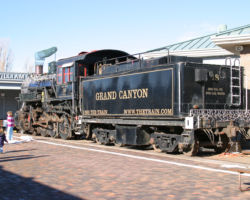
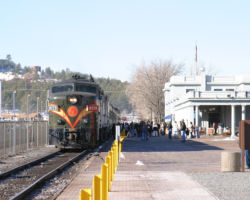
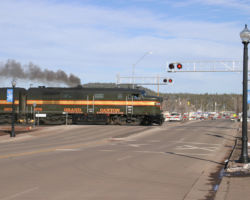
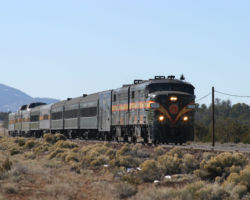
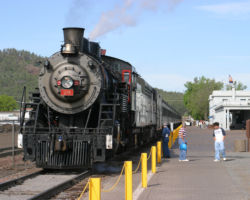
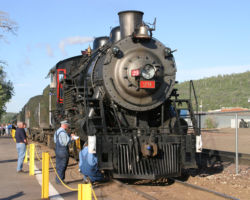
Copper Basin Railway & Miscellaneous
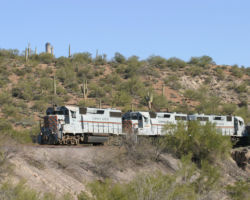
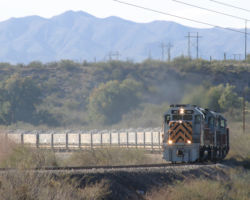
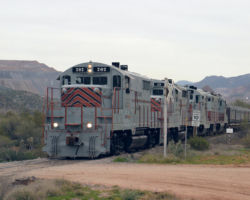
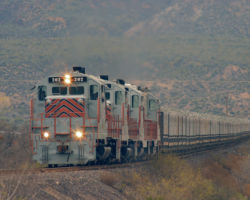
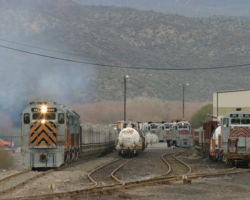
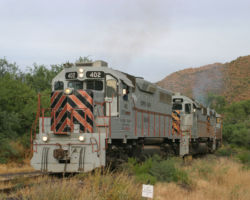
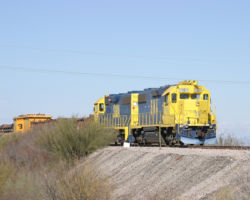
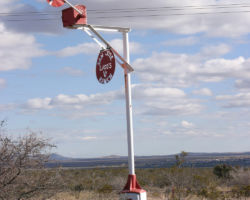
All photographs in this trip report were taken with a Canon EOS 10D using either a Canon 28-105mm USM or a Canon 75-300mm f4-5.3 IS/USM.
This work is copyright 2024 by Nathan D. Holmes, but all text and images are licensed and reusable under a Creative Commons Attribution-NonCommercial-ShareAlike license. Basically you’re welcome to use any of this as long as it’s not for commercial purposes, you credit me as the source, and you share any derivative works under the same license. I’d encourage others to consider similar licenses for their works.
